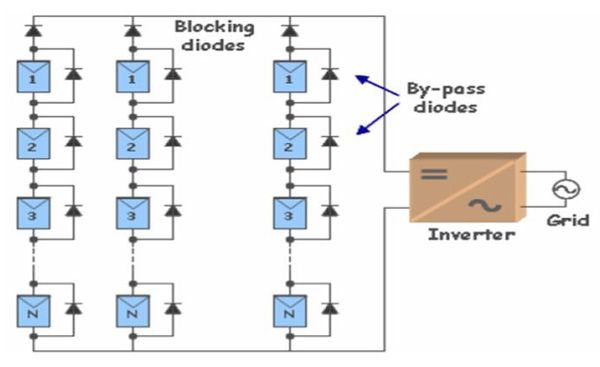Monitoring is the key to unlocking the energy production of the solar cell. It is easy to lose efficiency through the use of circuit architectures that assume constant energy production when the solar environment is constantly changing.
The change in current-voltage properties as a solar module heats up or receives more light can be an important source of efficiency losses in solar arrays. If the inverter that generates grid-compatible electricity is not tuned to the output voltage and current conditions, it will waste more of the electricity than it should. In response, electronics companies have produced ICs that perform the maximum power-point tracking (MPPT) needed to optimize energy conversion as well as bypass electronics to prevent temporarily unproductive modules from disrupting the output of active cells.
Close to the equator on a clear day, energy from the Sun means that a single square meter of Earth’s surface receives more than 1 kW of power. Today’s solar cells make it possible to convert a significant portion of this energy into electricity. Silicon-based solar cells tested under laboratory conditions have achieved conversion efficiencies approaching 25 percent. However, these cells have not made it into production photovoltaic (PV) panels, and even if they did there are other issues that reduce the efficiency of the total PV system.
The electronic controls behind the solar cells provide the key to leveraging the raw efficiency of the solar cell. The control systems need to be able to react to changing weather conditions to ensure that the PV cells and modules operate as close to their peak as possible. Each solar cell has a characteristic current-voltage (IV) curve that reflects its response to both temperature and incident-light levels.
The cells packed into a photovoltaic module might generate a high voltage but very-low current on a drab winter day. As light levels rise the voltage will drop slightly, but current will increase dramatically until it approaches its peak level. As the module heats up, the output voltage of the module will fall, reducing its overall energy output. As a result, even during periods of intense sunlight when they should be at peak efficiency, PV panels can suffer from significant drops in conversion efficiency if the electronic circuitry does not compensate for this.
Part of the secret to high efficiency lies in the use of components that minimize heat generation, so that output voltage is maintained at a high level. More important is an architecture that takes account of changing conditions to ensure that the cells and modules are operated at peak potential for the current conditions. Local shading will dramatically reduce the output of the shaded cells, with knock-on effects on modules that contain them and potentially complete PV installations or fields if not managed effectively. Shade falling on less than 3 percent of the area of a solar installation can reduce its output efficiency by more than 15 percent, according to tests carried out by the US National Renewable Energy Laboratory. If a cell is not producing energy, its resistance will rise and it will start to consume the current fed to it by other cells, as they are normally wired in series. The result is a build-up of heat. This hot-spot generation will damage the cells over time, as well as reduce the output energy of the entire solar array.
For more detail: Maximizing the Output from Solar Modules

